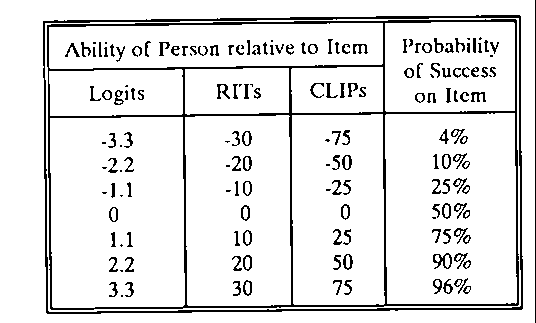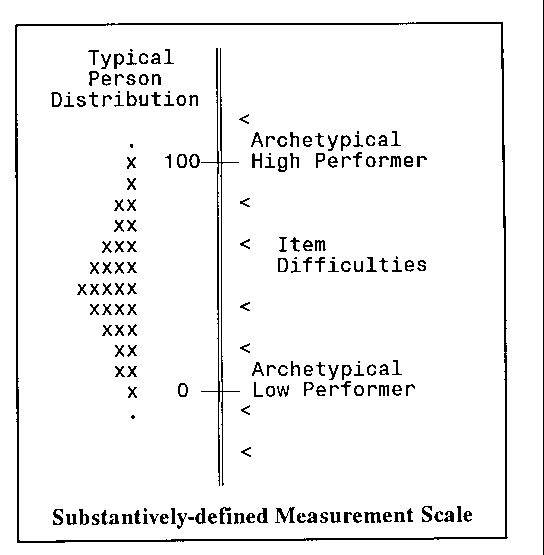

Linear measurement scales always have two arbitrary components: the location of the "zero" point and the size of the unit (implemented as another point on the scale). This gives scientists and practitioners an opportunity to choose values for these components which enhance the usefulness and meaning of their measures.
| Ability of Person relative to Item |
Probability of Success on Item | ||
| Logits | RITs | CLIPS | |
| -3.3 -2.2 -1.1 0 1.1 2.2 3.3 |
-30 -20 -10 0 10 20 30 |
-75 -50 -25 0 25 50 75 |
4% 10% 25% 50% 75% 90% 96% |
These choices are available in Rasch measurement. Most Rasch software routinely locates zero at the mean difficulty of the current set of items with units sized in logits, defined by the stochasticity of the local data. Other choices, however, maybe more useful. In order to give the scale unit a readily understandable probabilistic meaning, we can rescale the logit (see Best Test Design, p.191-204). For instance,setting 1 logit = 9.1 RITs (Rasch Units) or 1 logit = 22.7 CLIPs (Centrally Linear Probability Units) gives the equivalences shown in the Table.

Temperature benchmarks are substantive and hence independent of any particular data. For substantive Rasch benchmarks, imagine archetypical performers yielding the highest and lowest reasonable performances in the measurement context. Identify their locations on the measurement construct, either directly by inspection or via a hypothetical administration of the test protocol. Then label the measure corresponding to the lowest performance as 0, and that of the highest performance as 100. The logit distance between these points provides the linear conversion factor. Measures on this scale can then be communicated as representing the percent of achievement of goal status.
Prompted by an IOMC presentation by Carl V. Granger
Granger C.V. (1996) Marking out useful measures. Rasch Measurement Transactions 10:2 p. 497.
Marking out useful measures. Granger C.V. … Rasch Measurement Transactions, 1996, 10:2 p. 497
| Forum | Rasch Measurement Forum to discuss any Rasch-related topic |
Go to Top of Page
Go to index of all Rasch Measurement Transactions
AERA members: Join the Rasch Measurement SIG and receive the printed version of RMT
Some back issues of RMT are available as bound volumes
Subscribe to Journal of Applied Measurement
Go to Institute for Objective Measurement Home Page. The Rasch Measurement SIG (AERA) thanks the Institute for Objective Measurement for inviting the publication of Rasch Measurement Transactions on the Institute's website, www.rasch.org.
| Coming Rasch-related Events | |
|---|---|
| Jan. 16 - Feb. 13, 2025, Fri.-Fri. | On-line workshop: Rasch Measurement - Core Topics (E. Smith, Winsteps), www.statistics.com |
| Apr. 8 - Apr. 11, 2026, Wed.-Sat. | National Council for Measurement in Education - Los Angeles, CA, ncme.org/events/2026-annual-meeting |
| Apr. 8 - Apr. 12, 2026, Wed.-Sun. | American Educational Research Association - Los Angeles, CA, www.aera.net/AERA2026 |
| May. 15 - June 12, 2026, Fri.-Fri. | On-line workshop: Rasch Measurement - Core Topics (E. Smith, Winsteps), www.statistics.com |
| June 19 - July 25, 2026, Fri.-Sat. | On-line workshop: Rasch Measurement - Further Topics (E. Smith, Winsteps), www.statistics.com |
The URL of this page is www.rasch.org/rmt/rmt102d.htm
Website: www.rasch.org/rmt/contents.htm